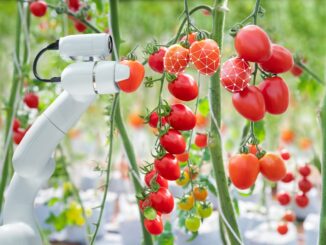When I say, tomato picking robot, what do you see?
A robotic arm? Something that gently grabs and picks the tomato? Maybe also the (autonomous) vehicle with that robot arm…. In short, hardware, something tangible, or as we also say, “something that hurts when you drop it on your toes.”
However, a robot is much more than the hardware. For this we first go back to a commonly used definition of a robot:
“A non-biological, physical system that sees the world around it and reacts to it.”
We break it down into “sense”, “think” and “act”.

The first step, sense, is about observing the environment. For this purpose, sensors are used that can see, smell, feel or hear the environment. Depending on the application, it can be a simple camera that can only distinguish between light and dark, but it can also be a lidar so that a very precise 3D representation of the fruit and its environment can be made. The data from these sensors is stored for use in the next step.
The second step, think, is about making decisions based on what is observed in the environment. The data collected in the first step is analyzed and a decision is made on what should be done. In the example of the tomato picking robot we have to determine whether the tomato is ripe and needs to be picked. Models and artificial intelligence play an important role in this.
In step three, act, an action is performed. Hardware often is an important part of this. The fruit is picked by gripping it with a gripper, using suction it with a vacuum cleaner-like system or, in the case of a vine tomato, cutting.
So for these three steps a lot of technology is needed. From the gripper’s hardware, materials and electrical engineering, to the software that allows the harvesting vehicle to drive autonomously using position determination, data storage, sensors and AI, a robot consists of many different parts.
But it does not stop there either, in order to develop the models that determine what must be done, the knowledge from the growers is needed. Which tomato is ripe and which one should be picked the next day? Furthermore, the data must of course be stored securely. A picked fruit has to be taken to the shed for sorting and packing. The origin of the fruit should be stored and passed on further up the chain. Perhaps we are using blockchain here to make this more transparent.
To complete the picture, it is important that the data from the cultivation itself is also included. After all, the temperature, amount of light and all actions during cultivation affect the shelf life and quality of the fruit. For this, the data from the harvest should be combined with, for example, that of the climate computer and sensors that are installed in the greenhouse. In the next phase, the temperature, humidity in the truck and the duration of the transport are important for the quality. With that transport, the shelf life and the traceability of the product, we come to the reason why we develop all these systems. As the Netherlands, we are the second largest exporter of food in the world. Still bizarre to realize that we just do that in such a small country!
If we want to continue doing that in the coming decades, our system will have to change and we will have to make more use of the available technology. This change has already started! Where we used to send planes full of peppers all over the world, we now produce much more for our direct region, a radius of about 500 kilometers around the Netherlands. In addition, we provide worldwide knowledge and technology so that food can be produced worldwide in a sustainable way.
We will have to work together even more to maintain this leading role. We have a lot of green knowledge and companies that have been developing technology that is sold worldwide for decades. However, the development of technology is now going so fast that we can no longer develop it all ourselves. This requires collaboration with universities, developers from other sectors, the government, but also companies in the horticultural sector. For this we need to work with companies that are developing technology worldwide. We are not just talking about “simple” automation but about digital transformation.
So let’s develop products and services together by making use of the knowledge that’s available worldwide, both inside and outside of the horticultural sector instead of all inventing our own wheel with the doors closed!





Be the first to comment